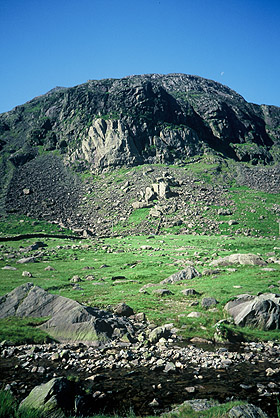|
NWB.com was very grateful to receive the following letter from the Rock Exploration Department at Bangor University. With the application of this simple formula all intrepid bouldering activists can make accurate value judgements about distant boulders, and thus reduce the amount of unnecessary bog trotting.
Dear NWB.com
With reference to the recent controversy surrounding the Boulder of the Month feature, I thought it best to clarify the mathematical principles relating to Craine's 1st Law.
Recent publications in The Journal of European Union Boulder and Outcrop Utilization Regulations (JEUBOUR) have explained, in simplistic terms, the derivation of Craine's 1st Law.
Consider a boulder or outcrop a horizontal distance x away and on a higher plane than the approach. The actual height, H, of the boulder is equal to this distance, x, multiplied by the tangential angle (above the horizontal) as one views its summit minus the tangential angle as one views its base:
H = x tan(α1) – x tan(α2) (1)
where α1 is the angle from the horizontal to the summit and α2 is the angle from the horizontal to the base.
Now Craine’s 1st Law uses the assumption that parameter β (equation 3) is influential in determining H. This area of research is highly volatile at present and many local activists are choosing to neglect β in their calculations.
So Equation (1) becomes Craine’s Illusionary Height, h:
h = x tan(α1) – x tan(α2) + β2 (2)
where
β = λ + x (3)
and λ is the time lapsed (seconds) from a previous boulder discovery.
As one can see, as one gets closer to the boulder and if one is more prolific in the discovery of new material, the β-parameter is quadratically reduced.
Best regards,
Professor Sloper
University of Bangor, Rock Exploration Department
Relevant links:
|



